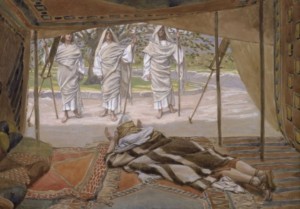This week’s parasha, Vayera, begins with Abraham sitting outside his tent just days after circumcising himself at the age of 99. We would expect him to be weak and frail at this moment, yet he is spry and full of energy. The Torah tells us that it was a very hot day (Genesis 18:1), and the Sages explain (as cited by Rashi on the verse) that God deliberately made it hot so that Abraham should not have any visitors bother him during his recovery. Yet, Abraham was more pained by the lack of visitors than he was from the circumcision! So, God sent him three angelic guests.
Abraham immediately sprung into action, bringing water for his guests to wash their feet, and cooking up a feast. Abraham served his guests “cream and milk and the calf that he had made, and he placed [them] before them, and he was standing over them under the tree, and they ate.” (Genesis 18:8) As discussed in the past, the Sages were puzzled at the fact that Abraham served both dairy and meat at the same meal. Although he lived before the official giving of the Torah, and therefore was not bound by Torah law, nonetheless we would expect him to observe the eternal Torah anyway. Jewish tradition holds that the Patriarchs also observed the Torah through an oral tradition and through their direct prophetic knowledge from God.
One solution to the problem comes from another tradition that Abraham had received the secret wisdom of Creation, and was actually the originator of Sefer Yetzirah, the “Book of Formation”. He knew how to use mystical powers to create things out of thin air. Hence, when the Torah says “the calf that he had made [asher asah]” it means that he literally made the calf! Since he had made this hunk of meat, it was never a living animal, and possessed no soul, so it was totally pareve, and he could serve it with “cream and milk”. The Talmud (Sanhedrin 65b) tells us that Rav Chanina and Rav Oshaia would study Yetzirah and similarly create a calf out of thin air which they then consumed.
Meanwhile, in last week’s parasha we saw how Abraham took on the united armies of four powerful kings. The Torah tells us that he fought them off with just 318 of his men (Genesis 14:14). If this wasn’t enough of a miracle, the Sages say (as cited by Rashi on the verse) that Abraham really didn’t have 318 men. Rather, 318 is the gematria of “Eliezer” (אליעזר), Abraham’s devoted servant. It was just Abraham and Eliezer taking on an entire army! How could they do this? The Talmud (Sanhedrin 109a) says that when Abraham would throw dust and straw it would transform into swords and arrows in mid-air. That’s quite the superpower!
Judaism is full of such feats of superpower, whether it’s Jacob pushing off a well-stone on his own (Genesis 29:1-10)—when normally it required a team of shepherds—or Samson crushing a thousand Philistines with a jawbone (Judges 15), or figures like Eliezer and Eliyahu employing kefitzat haderekh, “leaping” or “teleporting” across vast distances (see Sanhedrin 95a-b and Kiddushin 40a). It therefore isn’t surprising that the modern “pantheon” of superheroes was crafted almost entirely by Jewish writers and artists.
The Jews Behind Comics
In 1933, a struggling New York Jew named Max Ginzberg (1894-1947) had an idea. He just started a new job as a salesman for a printing company, and enjoyed reading the newspaper’s short comic strips. What if, he thought, the comic was not a short sketch but a full-length work of art that told a richer story? Though his superiors weren’t thrilled with the idea, one of his managers (another Jew named Harry Wildenberg) gave Ginzberg a shot. Ginzberg produced an 8-page comic “pamphlet” and it was an instant hit—as well as an awesome marketing tool for the company’s client, Procter & Gamble. Shortly after, Ginzberg (going by the name Max Gaines) produced a longer 36-page comic book, Famous Funnies.
Famous Funnies got to the hands of aspiring fiction writer Major Malcolm Wheeler-Nicholson (1890-1965, who was not Jewish). He loved the idea and started working on his own comic books. Meanwhile, Ukrainian-Jewish immigrant Jack Liebowitz (1900-2000) teamed up with Romanian-Jewish immigrant Harry Donenfeld (1893-1965) to start a new publishing company. Their company soon absorbed Wheeler-Nicholson’s, and took on Ginzberg as a partner, eventually giving birth to Detective Comics, or DC Comics, in 1936. It was there that Jewish duo Jerry Siegal (1914-1996) and Joe Shuster (1914-1992) revealed an old superhero they dreamed up years earlier, Superman. Superman first appeared in an issue of Action Comics in 1938.
The following year, another Jewish duo, Robert Kahn (“Bob Kane”, 1915-1998) and Bill Finger (1914-1974) introduced Batman. A couple of years after that, yet another Jewish pair, Jacob Kirzberg (“Jack Kirby”, 1917-1994) and Hymie Simon (“Joe Simon”, 1913-2011) came up with Captain America. Most famously, Stanley Lieber (“Stan Lee”, 1922-2018) helped bring to life Spider-Man, the Fantastic Four, Hulk, Iron-Man, the Avengers, and the X-Men, working for Marvel Comics—originally started by another Jew named Martin Goodman (1908-1992).
It was Stan Lee who transformed the comic book industry into a bona-fide giant. He did this with his new wave of deeper, richer stories that went beyond the simple good-and-evil, hero vs. villain narrative. He introduced more complex themes and moral dilemmas, which proved hugely popular. What was his inspiration? Lee admitted that a good deal of it came from reading the Tanakh, citing Scripture as being perhaps his greatest literary influence. He once said that the Bible was “definitely on my mind when I was writing things like Thor.”
What does all of this have to do with this week’s parasha? It turns out, the modern comic books industry can actually help us understand the Torah (and the rest of the universe) on a much more profound level.
The Multiverse
One of the biggest questions (and sometimes, criticisms) of Judaism is how we can have so many different opinions about basic facts. For example, in this week’s parasha we read about the Akedah, the “Binding” of Isaac. According to the accepted tradition, Isaac was 37 years old at this time. However, an alternate opinion is that Isaac was actually 26 years old, which makes more sense from the perspective of the age of his future wife, Rebecca (see Tosfot on Yevamot 61b). Well, which is it? Was he 26 or 37? Surely, it cannot be both! The same goes for the narrative of Abraham’s calf, with which we started above. Did he create the calf or not? And did Abraham have 318 fellow fighters in the War of the Kings, or was it just Eliezer? Some hold that it was just Eliezer, while others (like Rabbeinu Bechaye and Gur Aryeh) insist he really did have 318 fighters with him, at least initially.
Despite these apparent contradictions, no one will boldly claim that a certain opinion is outright wrong. We accept all of these commentaries as equally valid and holy. Oftentimes, we go so far as to say elu v’elu divrei Elohim chayim—both “these” and “these” are the Word of God. As nice as this statement is, it appears to defy logic. Or does it?
The comic book world (lehavdil!) has a similar problem. Over the decades, so many storylines have been written about the same characters that readers struggled to find the definitive “canon”. Thankfully, science came in with an idea that would solve the problem: the multiverse.
In brief, the multiverse refers to the notion that there are other universes out there which parallel our own. There are many variations of this concept. The most extreme posits that there are infinite universes, and each of us exists in each of them—with a slight modification. Some hold that every major choice we make creates a “split” universe where we made the opposite choice. (I’ve always wondered if, when we dream, our souls get a glimpse of ourselves in other dimensions—which would explain why dreams seem so real!) Others see the multiverse as a place of alternate timelines, alternate laws of nature, or alternate realities. This is great for comic books, where an infinite number of parallel storylines can be written for a single character, all fitting within the official “canon”.
In 2010, a group of scientists analyzing data from the Wilkinson Microwave Anisotropy Probe suggested that they found evidence of colliding universes. Others quickly rejected the findings. From a strictly theoretical-physics perspective, the math does allow for a multiverse. One of the most popular theories in physics today is string theory, which may very well end up being the “Grand Unified Theory” (GUT) that can explain everything in existence. The notion of a multiverse is part and parcel of string theory (especially M-theory). Today, many famous physicists are in support of the idea. Others continue to argue against it. Needless to say, the multiverse notion is highly controversial, though certainly intriguing.
What is even more intriguing is that some of our rabbis discussed this idea long ago. In fact, it is a fundamental aspect of Jewish mysticism. Kabbalah speaks of four parallel olamot, or universes: Asiyah (which we inhabit), Yetzirah, Beriah, and Atzilut. Each of these is made up of ten “dimensions”, the Sefirot (fittingly, string theory posits ten dimensions as well). Each Sefirah is itself made up of another ten Sefirot, making one hundred in total. Having said that, Rabbi Chaim Vital writes in his introduction to Etz Chaim, the mystical textbook of the Arizal (Rabbi Itzchak Luria, 1534-1572), that “even though we said [the dimensions of Sefirot] total one hundred, each and every one of them is really an infinite number…” Could there be an infinite number of parallel worlds out there?
In The Breath of Life (pgs. 110-111), Rav Yitzchak Ginsburgh writes:
In general, there should be no inconsistencies among the commentaries regarding Biblical situations, which obviously occurred in one way or the other. Nonetheless, there are often controversies regarding the true facts… Rebbe Isaac of Homil explains that there are multiple dimensions of existence in which different realities, even souls, exist simultaneously on different planes… In Asiyah, twins or a married couple appear to be two different people but in Yetzirah they are the same soul…
He brings one example regarding Keturah, the later-wife of Abraham. Some say she was the same person as Hagar, while others say they were two distinct women. Rabbi Yitzchak Eizik Epstein of Homil (1770-1857) posited that in the realm of Yetzirah, Hagar and Keturah were indeed one person, but in this realm of Asiyah, they appeared as two different women, despite sharing one soul! Perhaps we can take this concept further and suggest that all apparent differences of opinion in the Torah are owed to alternate realities.
Maybe in one dimension, Isaac was 37 years old at the Akedah, while in another he was 26. In one world, Abraham was a mystic with supernatural abilities—creating calves and turning dust into swords—while in another he was simply a humble teacher with a large following, and served meat and dairy because this was not forbidden at the time. This might even explain the ancient teaching that God “rides through 18,000 worlds” (see Avodah Zarah 3b and Zohar I, 24a, both based on Psalm 68). The multiverse may be an elegant solution to the alternate realities of our Torah commentaries, and might just serve as some scientific proof for the age-old dictum, elu v’elu divrei Elohim chayim…



Pingback: Torah Simulation Theory | Mayim Achronim